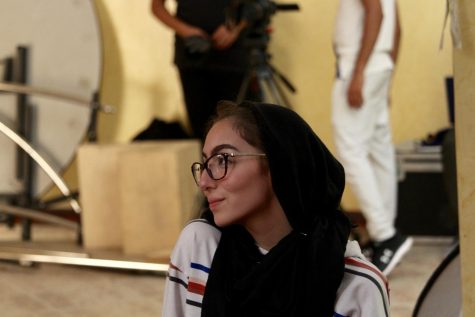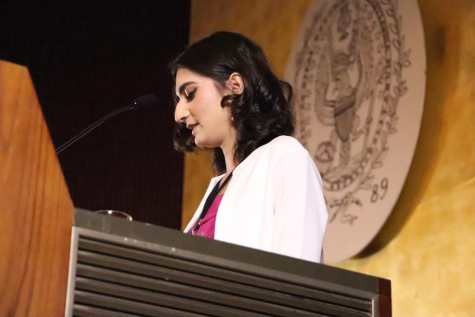Students Raise Concerns About New Changes to NU-Q Media Awards

Every year, NU-Q students are given the chance to win awards for their film, video, photography and writing work at the NU-Q Media Awards, which has also been called the “mini Oscars” by students. But this year, some students are up in arms over changes to the competition’s categories and rules.
The awards ceremony has been renamed the NU-Q Media and Research Awards to also acknowledge the different types of research that are conducted by NU-Q students.
“Previous years did not have a full representation of the student research here,” said Greg Bergida, the university’s director of student affairs, who was also chair of the organizing committee for the awards.
The Research awards are now divided into two categories, one for humanities and the other for social sciences.
“It’s a chance to celebrate [our] hard work because sometimes we spend months writing papers and they just end up on the professor’s desk with a grade,” said Najla S. Al-Khulaifi, president of the Student Union at NU-Q and the student consultant awards committee. The union organizes the award ceremony as part of Go Wild Week, an NU-Q tradition meant to raise school spirit.
Another major change is the dramatic reduction in the number of categories of awards – from 17 to 8. Previous years included several separate categories for journalism and communication work, such as breaking news, feature news, hard news for print journalism entries, and editing, cinematography and sound design for communication students who produced films. But now, according to the awards application that was distributed to students via email, all journalism print work will fall under the broad category of Journalistic Writing.
Other similar broad categories include Creative Writing, to which communication and journalism students can submit non-expository written work, such as screenplays and poetry; Multimedia, meaning any student work that employ various forms of visual media, such as photo slideshows or website projects; Documentary for all visual work “that falls under the documentary mode of production,” regardless if it was produced by a communication or a journalism student; Fiction for visual stories that are completely made up or are a fictional retellings of true events; and News for broadcast news packages and photojournalism work.
These changes allow all students to submit their work to any of these categories, said LaKisha Tillman, the student and residential life manager at NU-Q. She added that the past method was not consistent with the “holistic” approach that the university is trying to pursue since students could only submit work to the categories related to their majors.
Members of the organizing committee said the decision to reduce the number of categories would help to increase competition among students.
“Having fewer categories than we had in the past helps us focus on some of the fine top pieces,” Bergida said. Al-Khulaifi agreed. “The reason behind the reduction of these categories is to make sure that we get the highest quality of work,” she said.
However, many students are not happy with this change.
“This new change has completely ruined the concept of media awards,” said Shahnawaz Zali, a communication senior at NU-Q. Since communication students have different classes in cinematography and editing, and journalism students have courses that focus on different aspects of news production, these specialties should also be reflected in the awards as separate categories, he said.
“Some cinematography projects may not have a strong story but their cinematography is beautiful. They should be recognized and awarded for it,” he explained.
Syed Owais Ali, a communication senior, agreed, adding that since all student work is eligible, including those produced outside the classroom for professional media organizations or those supported by grant funding, this puts some students at an unfair advantage.
“Classwork and independent projects are being compared at the same level, which means that a QR 25,000 project will be competing with students’ classwork, which might have been made with QR 500,” he said. “This is not good for the future of the university. It discourages students, especially underclassmen. If young filmmakers, young writers and young journalists are discouraged, they will not be motivated to do more and get recognized for that.”
Other students said it was unfair of the committee to change the name of the awards without adding more categories that represent the journalism and communication majors.
“Although I really respect research, I believe that communication and journalism students work tirelessly, for endless hours in and outside their classes, so if research is being added as an important component of the award, it should be included with a greater number of categories for journalism and communication awards,” said Layan Amin, a senior communication student at NU-Q.
Al-Khulaifi said, as the president of the study body, she will work with students to address these complaints and come to a decision that will hopefully satisfy all parties.
The judging process has also changed for this year’s competition.
Student work now will be judged in two phases: select faculty will choose the best five pieces of content from each category, after which a set of external jurors from various professional media organizations and other academic institutions will choose the winners, explained Al-Khulaifi, who added that this is “to ensure that the best quality of work is awarded.”
On March 23rd, nominees will showcase their work all day before the official awards ceremony in the evening. “This will make the awards ceremony in the evening even more meaningful because it will be a community effort,” said Tillman.
Zali and Ali said they are considering organizing a student petition to protest the reduction in the number of categories.
However, they do not disapprove of all the changes. Zali said showcasing the work of the nominees before the ceremony is a significant step in recognizing NU-Q talent.
“I think that’s a really good idea. Not only does the NU-Q student community get to see the amazing work of all the talented students,” he said, “but it gives a chance to their family members to see for themselves all the hard work their children have done.”
Jia Naqvi, a journalism sophomore at NU-Q agreed. “The fact that they’re allowing families to come and look at the work will raise greater awareness of student work at NU-Q and even lead to more applicants for admissions in the future,” she said.












